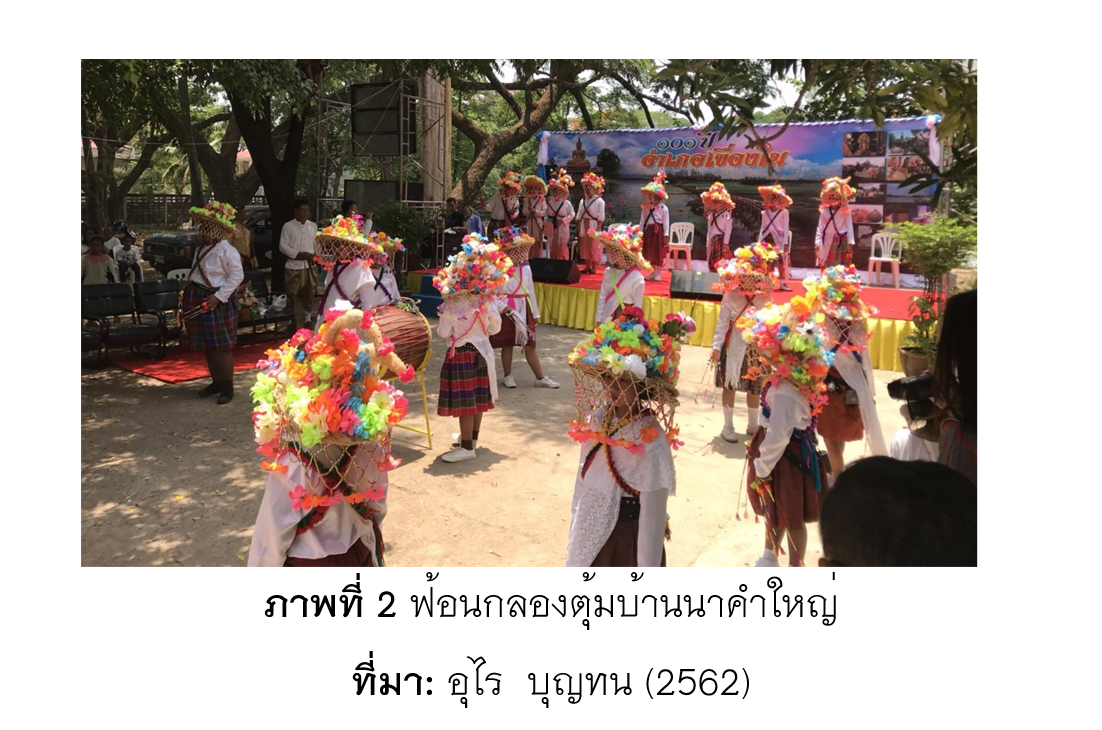Forms and Cultural Reproduction Rituals Fon Kongtum
Keywords:
Forms, Cultural Reproduction, Fon KongtumAbstract
This research aims to Study the history, form, composition And Reproduction Cultural Rituals Fon Kongtum . an Na Kham Yai, Na Kham Yai Subdistrict, Khueang Nai District Ubon Ratchathani Province, Ban Phueng, Tham District, Kanthararom District Srisaket Province. By using qualitative research methods With data collected by How to study from documents And interviews The research found that. History of the ritual, drum dance, Ban Na Kham Yai and Ban Phueng. There are people from Laos who migrated to settle in Thailand. Therefore brought this culture of ritual Fon Kongtum But not recorded Who is the one who invented the dance. The dance style of the two villages will have a traditional dance style, with no fixed plan. Focusing on the wrist flick And to the arms up and down Distinctive appearance.
The dance moves backwards, and the men are tied together or not tied, depending on the agreement of the participants. The bee house will have a steer. Row pattern and dance in both villages. Divided into 2 types: 1) used in merit-making tradition as a single row 2) Used in dancing that is not a merit-making tradition There will be an adjustment of the row pattern to suit the area, such as the circle row, the V-shaped row, the dance position of the bee house will have 5 additional positions. Instrument Kongtum and PhangHard. Clothing, accessories and dress methods are the same, but Ban Na Kham Yai. There will be no ankle gains. The materials and colors used will be different. Opportunity used in dancing 1) In the tradition of Bun Fai 2) Annual merit 3) Welcome the guests Repetitive cultural production, ritual Fon Kongtum. Ban Na Kham Yai and Ban Phueang. Has been produced by ancestors inherited by observing, remembering and performing To the children in the village And have published in 3 ways As follows 1) Teaching in youth in the village 2) Provide learning resources to outsiders 3) Join the show that invited to join Consumption is divided into 2 categories 1) outsiders 2) insiders And repeated production The ritual of the drum dance is repeated continuously. By persons within the community address and to external persons who come to study to learn view Can understand Content and meaning Of ritual Fon Kongtum The Fon Kongtum ritual has been produced, published and reproduced. For a long time from the past - to the present. There are both increasing posture Reducing dress or rare materials. Reduce the formatting of the dance. And have changed somewhat over time But there are also some dance styles and elements That has been published and reproduced Thus causing the culture of the ritual, the Fon Kongtum of Ban Na Kham Yai and Ban Phueang Still inherited today
References
กาญจนา แก้วเทพ และ สมสุข หินวิมาน. (2551). สายธารแห่งนักคิดทฤษฎีเศรษฐศาสตร์การเมือง กับการสื่อสาร ศึกษา. กรุงเทพฯ: ห้างหุ้นส่วนจำกัดภาพพิมพ์.
คำหล่า มุสิกา สัมพันธ์ สุวรรณเลิศ และ บุญส่ง สร้อยสิงห์. (2552). รายงานวิจัยฉบับสมบูรณ์โครงการการอนุรักษ์พิธีกรรมและการแต่งกายในการฟ้อนกลองตุ้มจังหวัดอุบลราชธานี. มหาวิทยาลัยอุบลราชธานี: สำนักงานกองทุนสนับสนุนทุนการวิจัย.
ดวงพร คงพิกุล.(2555). การผลิตซ้ำทุนทางวัฒนธรรม:กรณีศึกษาโรงเรียนพระหทัยคอนแวนต์. วิทยาศาสตร์มหาบัณฑิต (วท.ม.), สถาบันบัณฑิตพัฒนาบริหารศาสตร์, กรุงเทพฯ.
วรรณิกา นาโสก. (2551). พัฒนาการฟ้อนกลองตุ้ม อำเภอกันทรารมย์ จังหวัดศรีสะเกษ. วิทยานิพนธ์ศิลปกรรมศาสตร์มหาบัณฑิต (ศศ.ม.), จุฬาลงกรณ์มหาวิทยาลัย, กรุงเทพฯ.
ลัดดา จิตตคุตตานนท์. ( 2552). การวิเคราะห์การสื่อสารเชิงวัฒนธรรมเพื่อการดำรงอยู่และสืบทอดประเพณีบูชาอินทขิล. มหาวิทยาลัยธรรมศาสตร์, กรุงเทพฯ.

Downloads
Published
How to Cite
Issue
Section
License
ผู้นิพนธ์ต้องรับผิดชอบข้อความในบทนิพนธ์ของตน มหาวิทยาลัยพะเยาไม่จำเป็นต้องเห็นด้วยกับบทความที่ตีพิมพ์เสมอไป ผู้สนใจสามารถคัดลอก และนำไปใช้ได้ แต่จะต้องขออนุมัติเจ้าของ และได้รับการอนุมัติเป็นลายลักษณ์อักษรก่อน พร้อมกับมีการอ้างอิงและกล่าวคำขอบคุณให้ถูกต้องด้วย
The authors are themselves responsible for their contents. Signed articles may not always reflect the opinion of University of Phayao. The articles can be reproduced and reprinted, provided that permission is given by the authors and acknowledgement must be given.







